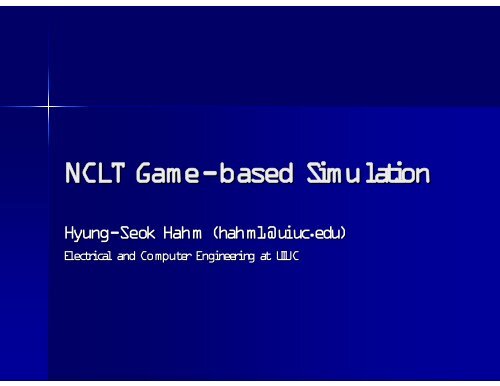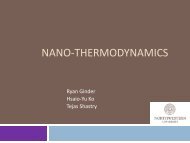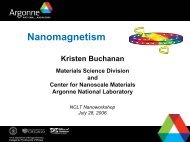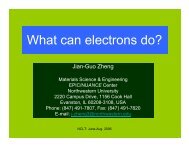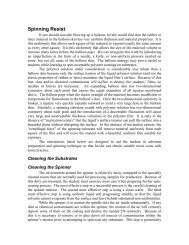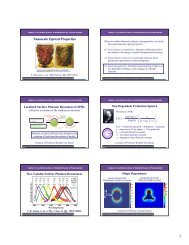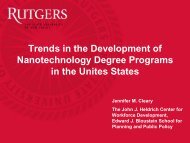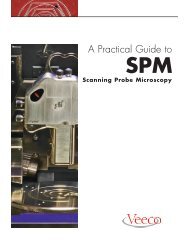NCLT Game-based Simulation
NCLT Game-based Simulation
NCLT Game-based Simulation
You also want an ePaper? Increase the reach of your titles
YUMPU automatically turns print PDFs into web optimized ePapers that Google loves.
<strong>NCLT</strong> <strong>Game</strong>-<strong>based</strong> <strong>Simulation</strong><br />
Hyung-Seok Hahm (hahm1@uiuc.edu)<br />
Electrical and Computer Engineering at UIUC
Motives<br />
• Target users: Grade 7 – 16 (Video game<br />
generation)<br />
• To provide intuitive feel<br />
– <strong>Game</strong> has 3D visualization,touch, feel & sound<br />
effect<br />
⇒Good to show dynamic features of Nanoworld
Motives (con ( con’d)<br />
• Interaction is effective in learning<br />
• Zoom -in interface allows students to make<br />
logical connections between Nano and<br />
Macroscopic worlds
Related Work<br />
• Hapticinterface interface in Nano education<br />
– Nanomanipulator by CISMM at UNC-CH<br />
CH<br />
• 3D game interface in Nano education<br />
– Nanokids by James Tour at Rice University
Related Work (con ( con’d)<br />
• <strong>Game</strong> principles in education<br />
– James Gee and Kurt Squire at UW-Madison<br />
• Video games in education<br />
– Commercial products:V. Smile (VTech ( VTech)<br />
– <strong>Game</strong>s-to<br />
to-Teach by Henry Jenkins at MIT<br />
⇒ The Education Arcade in joint with Microsoft
SuperCharged!<br />
• 3D racing game in electromagnetism<br />
environment<br />
• Goal<br />
– To learn electrostatic forces, magnetic fields,<br />
and electric fields
SuperCharged! ! (con ( con’d)<br />
• How to play<br />
– Navigate the world with joystick by adopting the<br />
properties of charged particles and placing<br />
other charges inthe environment<br />
• Usage<br />
– Adopted as a teaching materialin<br />
undergraduate physics class at MIT<br />
• Screenshots
Design Goals<br />
• Videogame Features<br />
– 3D Visualization<br />
– Joystick<br />
• Navigation<br />
• Force feedback<br />
• Ambient Learning<br />
– Popup Knowledge (inspired by Popup Videos from VH1)<br />
• Questions in context<br />
– Popup Questions
Design Goals (con ( con’d)<br />
• Attractive scenarios<br />
– Challenge-<strong>based</strong> game<br />
– <strong>Game</strong> levels depends on its size<br />
• Meters (Level 1), milimeters (Level 2), micrometers<br />
(Level3) & nanometers (Level 4)<br />
• In advancing to the next level,zoom-in interface<br />
plays a role
Design Goals (con ( con’d)<br />
• Attractive scenarios<br />
– Playeris given a mission in each level<br />
• Once the mission is completed, players may go to<br />
the next level<br />
• To accomplish the mission, players should make<br />
decisions <strong>based</strong> on theirknowledge
Prototype Demo<br />
• There is no levelchallenge yet.<br />
• 3D visualization is not fancy enough yet.<br />
• There is no sound effect yet.<br />
• There is no concrete game scenario yet.<br />
• The popup questions here are just selected<br />
randomly and not in context.In other words, they<br />
may be too difficulty for high schoolstudents.


